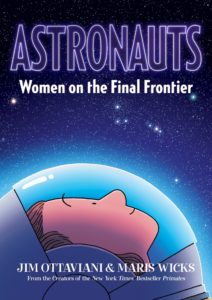Fleen Book Corner: Astronauts
Jim Ottaviani and Maris Wicks may be the most potent combination in nonfiction comics. How else to explain how they can spin such engagement and — dare I say it? — suspense from events past and in the public eye? They took the recent history of the three women who lived among Primates, and now they’re looking at the history of women in space in Astronauts, a copy of which was provided by :01 Books; pretty much everything in the book is available to anybody with access to interlibrary loan, but let’s tag this with spoilers, ahoy anyway.
Compared to Primates, Ottaviani and Wicks take a different approach this time around; last time they partnered, the book was told by an omniscient narrator, observing what Jane Goodall, Dian Fossey, and Biruté Galdikas did in their research on chimpanzees, gorillas, and orangutans (respectively). In Astronauts, the bulk of the story is told as remeniscences of its central subject, Mary Cleave, with forays into the experiences of other women who came before her.
In case you don’t recognize her name, Dr Cleave (biologist, ecologist, environmental engineer, and pilot from the age of 14) was a member of the 9th NASA astronaut group — the second recruited following efforts by Nichelle Nichols to broaden the pool of applicants beyond white guy test pilots — and really only applied because being an astronaut meant you had to qualify as a jet pilot and she always wanted to fly a plane with an afterburner. She twice flew into space on Atlantis, specialized in the operation of the shuttle’s robotic arm, and was instrumental in working out the design and operation of the NASA space toilet. After retiring from flight status, she served as head of NASA’s Science Mission Directorate.
And in telling her story, she tells the story of Valentina Tereshkova, of the thirteen women who passed every test that Mercury Seven did but weren’t allowed to join the astronaut corps, of the designers that made the Shuttle, of the astronaut one class in front of her that had the weight and eyes of the world on her as NASA’s first woman in space.
Oh, and she tells about how it took NASA 23 missions before they figured out that zero-G crumbs from sandwiches could be avoided by using tortillas, thanks to fellow STS-61-B rookie Rodolfo Neri Vela’s meal preferences. Sometimes the obvious answers aren’t obvious until you let somebody with a different background into your club, y’know?
Mary Cleave may not be the most famous astronaut you’ve ever heard of, but Ottaviani and Wicks found maybe the most typical member of the NASA astronaut program — whip smart, widely experienced, endlessly curious, problem solvers, people who maybe didn’t set out to be astronauts but wound up there because they had the skills to get there¹.
Being born in 1947, Cleave’s lifetime parallels that of crewed spaceflight; she was solo piloting about the time that Yuri Gagarin took the first human spaceflight. She was just about the same age at the time of her astronaut selection that Neil Armstrong was at his. She helped make the Shuttle workable for extended missions, and her first flight helped work out the construction techniques that would be used to build the International Space Station. She was instrumental in diverting Eileen Collins away from a career as a Mission Specialist and towards that of Pilot and Commander. Like I said, typical.
Astronauts is bookended with the idea of what an astronaut looks like, starting with a floating figure doffing the pressurized launch suit and only revealing Cleave on page two, and ending with pages of photos: Tereshkova, Ride, and Cleave, their cartoon representations next to their pictures.
This is followed by a two page spread of people whose faces we should know — Guion Bluford, Ellison Onizuka, Mae Jemison, Sunita Williams, Leland Melvin, Chris Hadfield, and more². It’s perfectly synced with the message of the book, and if, like me, you’ve spent your life looking up at those explorers that have left the bounds of Earth, it’s likely to inspire a tear or two.
We, as a species, made it to space, to the moon, to semi-permanent residence in orbit, because of women. We’re going back to the moon, and we’re not forgetting half of humanity this time. We’ll be going further in the future and that will require astronauts, who can no longer be picked from less than 6% of the planet’s population. Ottaviani and Wicks want you to remember that, and wants everybody reading Astronauts to ask themselves one question: What do you want to be?
Astronauts, by Jim Ottaviani (words) and Maris Wicks (pictures) is available at your local bookstore or comic shop starting today. It doesn’t shy away from the fact that we’ve lost astronauts, and you may need to explain about Apollo 1, Challenger, and Columbia; assuming that’s not a problem, it’s an ideal read for any wannabe astronauts or space enthusiasts with the patience to get through 160 pages.
Spam of the day:
TalkWithCustomer enables you to connect with a prospective customer at EXACTLY the Perfect Time. NOT with a form letter style email that looks like it was written by a bot.
Yeah? Why are you sending me a form letter, then?
_______________
¹ Or, as Cleave put it, I got my first job at NASA because I could fix the toilet.
² There are three photos that I didn’t recognize, and while I get the point Wicks and Ottaviani are making — astronauts can look like anybody — my only wish for the book is that might have included a key to the astronauts on those nearly-final pages.

The above comments are owned by whoever posted them. The staff of Fleen are not responsible for them in any way.